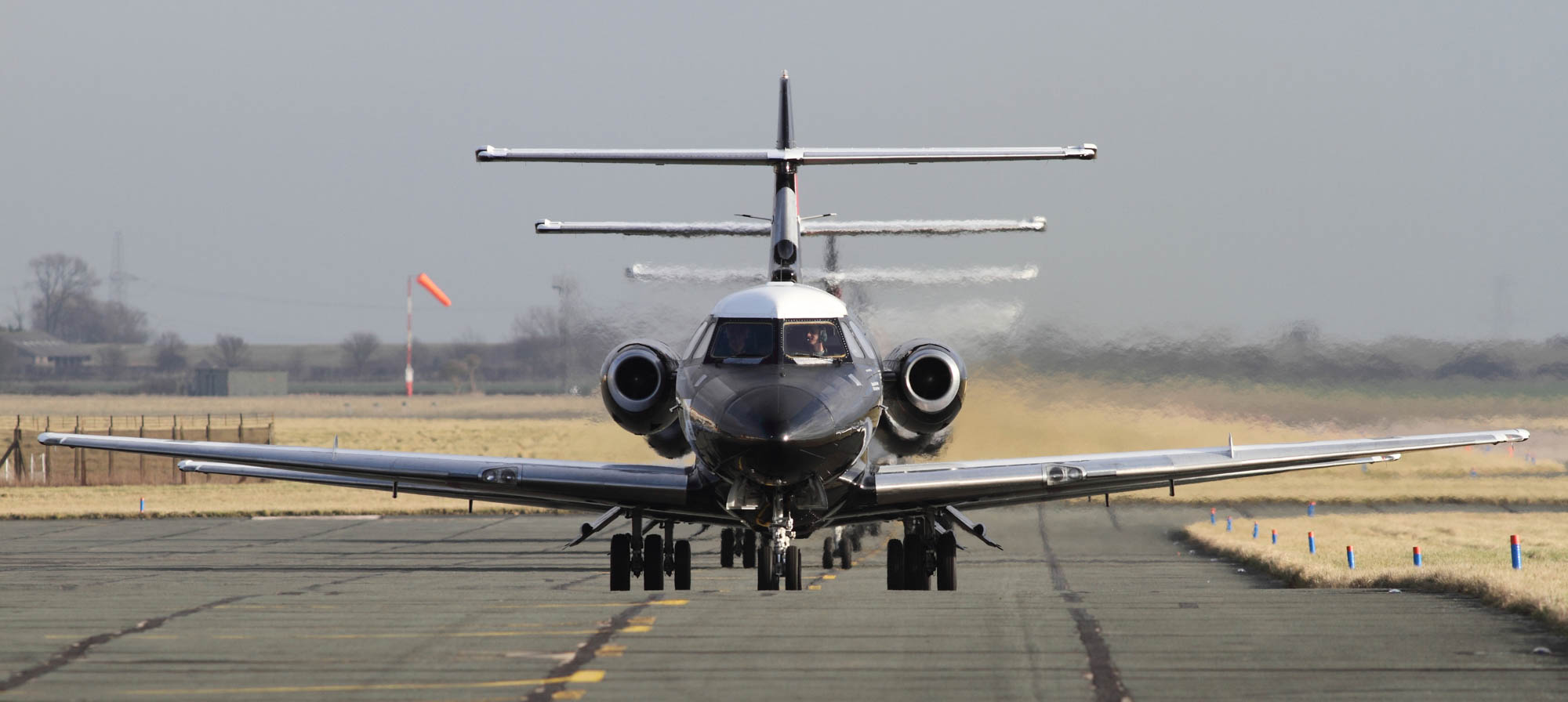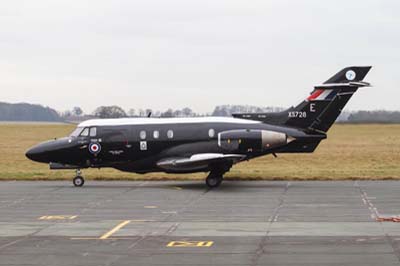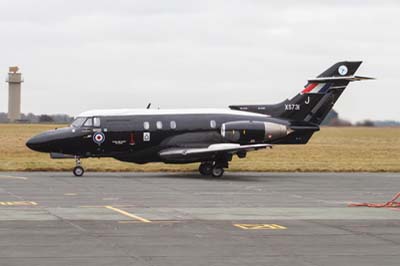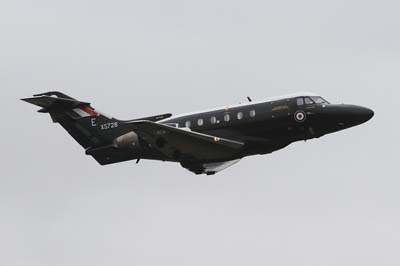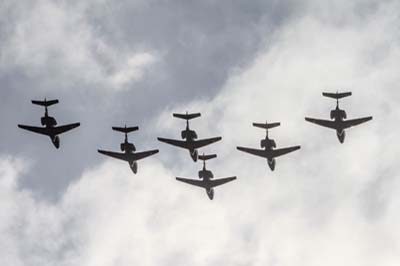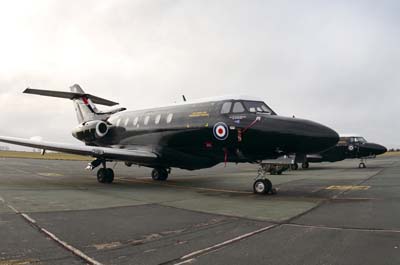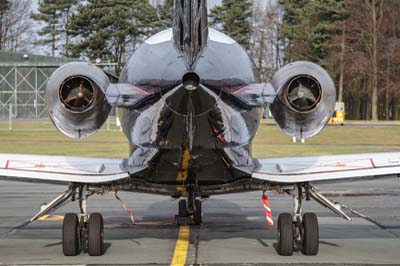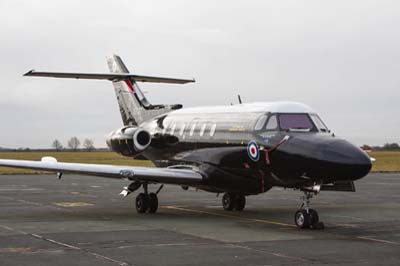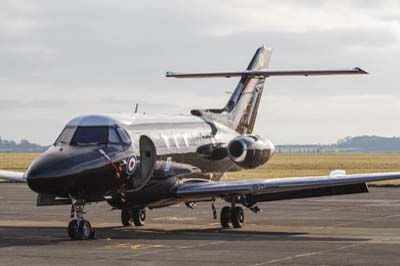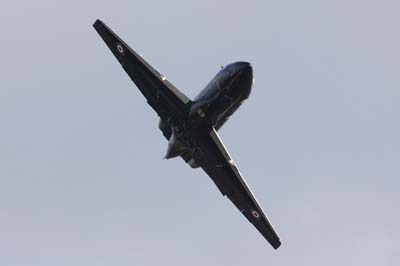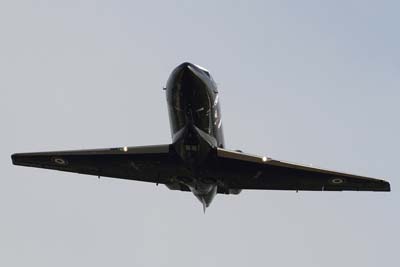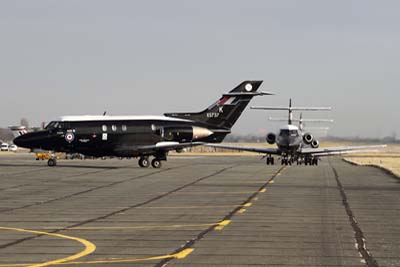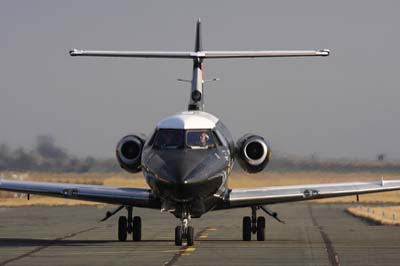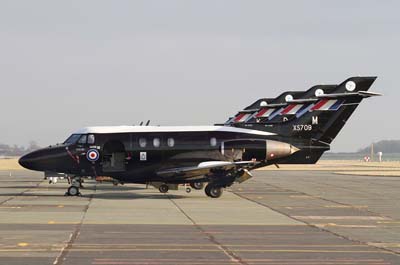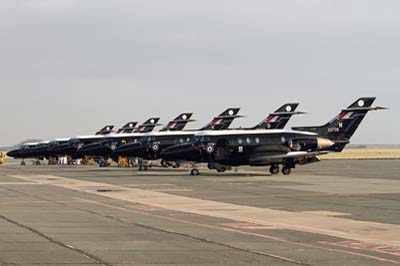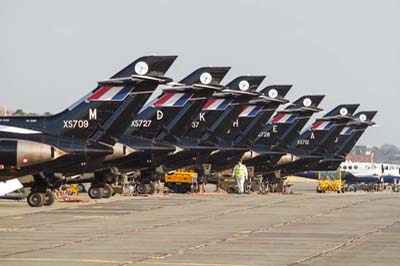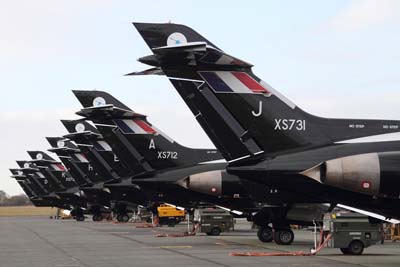The Dominie retires after 45 years of service
RAF Cranwell
3 FTS, 55(R) Squadron
January 20, 2011
|
| The dramatic effect of the Government's Strategic Defence and Security Review (SDSR) announced in October 2010 continues with another aircraft retirement, following that of the Harrier in December 2010. Today the Hawker Siddeley Dominie T.1 flew its last operational sortie from RAF Cranwell which has been its home since 1996. Six of the eight aircraft still flying took to the air lead by Wing Commander Suraya Marshall, Officer Commanding 55(R) for a final six-ship formation fly-past as a celebration of its long and valued service with the RAF. |
| The six-ship formation taxiing back to the ramp for the last time after 45 years of service. |
The final flypast
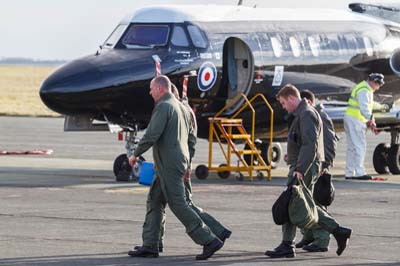
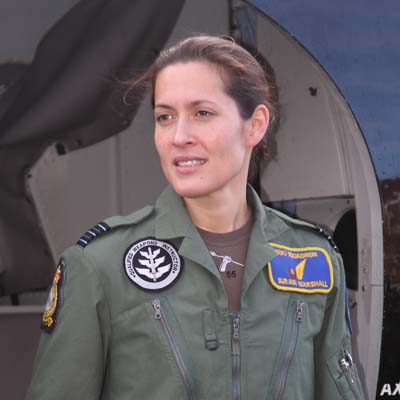 The formation took to the air in ten second intervals from 11:00 to return at precisely 12:00 in a tight six-ship formation flying north to south over the airfield having over-flown RAF Marham and RAF Coningsby. The formation turned for another fly-past down the line of the runway before breaking and landing. Each jet held on the taxiway to form a line which then made its way to the ramp in front of the 55(Reserve) Squadron hangar. Five came to a halt aircraft to face family and friends who were there to greet the crew, while Wg Cdr Marshall aircraft taxied around in front, for a very dignified and moving shut-down of the aircraft's engines in unison.
The formation took to the air in ten second intervals from 11:00 to return at precisely 12:00 in a tight six-ship formation flying north to south over the airfield having over-flown RAF Marham and RAF Coningsby. The formation turned for another fly-past down the line of the runway before breaking and landing. Each jet held on the taxiway to form a line which then made its way to the ramp in front of the 55(Reserve) Squadron hangar. Five came to a halt aircraft to face family and friends who were there to greet the crew, while Wg Cdr Marshall aircraft taxied around in front, for a very dignified and moving shut-down of the aircraft's engines in unison.
Wg Cdr Marshall stepping down her aircraft was very positive when talking about the retirement; "It's a sad moment but a day to celebrate what the Dominie has done for the RAF." Wg Cdr Marshall returned to Cranwell for the second time in August 2010, this time as the Commanding Officer of 55(R) Squadron; "I started training on the Dominie in 1996", adding "It's the end of an era for 55 our people have been placed elsewhere. It's sad stopping the Weapons Systems Officer (WSO) and navigator training. We still have Weapons System Operator (WSOp) training its ground based using simulators and computers."
Above left: Squadron Leader Stuart Reid leads fellow aircrew members away from their aircraft. For Sqn Ldr Reid it was his last flight as a pilot after 35 years of service in the RAF. Dominie pilots have been drawn from a range of backgrounds and are highly qualified with and average of 5,000 hours and some with as many as 12,000 hours of flying experience. |
 |
| The final six-ship formation arrived over its final target on time |
55(Reserve) aircrew training
55(R) Squadron reformed within 3 FTS at RAF Cranwell in 1996 after moving from RAF Finningley with eleven Dominies allocated to them. Navigator/WSO training commenced with students completing the Basic Dominie Module (BDM), which started with ground school and simulator sorties followed by six medium level flights to introduce them to the aircraft's systems, radar navigation and mental dead-reckoning. On qualification students progressed to either; rotary-wing, fast jet or maritime elements. Rotary-wing students moved to the Defence Helicopter Flying School at RAF Shawbury. Fast-jet students remained at RAF Cranwell for another eleven weeks for low-level radar training with the Fast Jet Training Flight (FJTF) on the Dominie. Maritime students also remained on the Dominie to learn low and medium level maritime techniques this course lasting twelve weeks.
With the FJTF students flew high-low-high profiles where the student had to navigate the aircraft to a low-level start point, fly a low-level route to a target and recover the aircraft to their home base or another airfield. Students were required to achieve an accuracy of +/- 15 seconds at all timing points along the route.
For the maritime role students progressed to the Basic Systems Navigation and Advanced Multi-Engine Training Flight. The aim of this course was to prepare the student for the Nimrod Operational conversion Unit at Kinloss. With the planned closure of RAF Kinloss and the retirement of the Nimrod R.1 (March 31, 2011) and the cancellation of the Nimrod MRA.4 also announced in the SDSR it eliminated the need for this course to continue. Likewise with the reduction of the Tornado GR.4 fleet and the retirement of the Tornado F.3 (March 31, 2011) similarly announced in October 2010 as part of the SDSR there would be surplus of WSO's within the RAF. Initially it was intended that the Dominie retire in December along with the Harrier but extreme winter weather prevented the current courses from being completed and it was decided that students should finish the courses, so the Dominie's retirement was put back three weeks.
Three years ago WSOs were streamed on the Tucano at RAF Linton-on-Ouse and not with 55(R) on a course that closely resembled the BDM phase. As the Dominie has retired two years earlier than its planned Out of Service Date (OSD) at short-notice it is undecided which aircraft will be chosen to replace it for future WSO and navigator training.
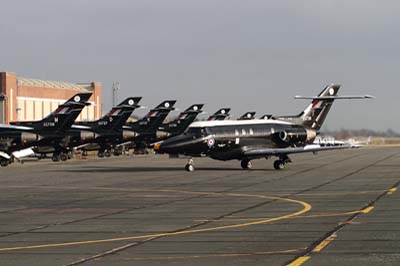 The Weapons Systems Operators (WSOps) training will continue with 55(R) at Cranwell in a reduced form as although the Nimrod R.1 is soon to retire the requirement for WSOps for the Boeing E-3D Sentry remains. The WSOp course is divided into two phases. The first phase lasts for 28 weeks and is concerned with mathematics, electronics and communication procedures. Survival training, simulator exercises and flying completed the practical element of the phase. Phase two divided the students into WSOp (Electronic Warfare) or WSOp (Accoustic Operators) courses which last for 27 weeks.
The Weapons Systems Operators (WSOps) training will continue with 55(R) at Cranwell in a reduced form as although the Nimrod R.1 is soon to retire the requirement for WSOps for the Boeing E-3D Sentry remains. The WSOp course is divided into two phases. The first phase lasts for 28 weeks and is concerned with mathematics, electronics and communication procedures. Survival training, simulator exercises and flying completed the practical element of the phase. Phase two divided the students into WSOp (Electronic Warfare) or WSOp (Accoustic Operators) courses which last for 27 weeks.
Dominie - 45 years of service
The Dominie T.1 was based on the Hawker Siddeley HS-125 a revolutionary business jet design which first flew in 1962. The RAF was looking for a jet aircraft to replace to very slow Vickers Varsity for jet navigators. The HS-125 was the ideal solution for the RAF and there subsequent order for the Dominie lead to the immediate success of the civil business jet. XS709 the first Dominie off the production line made its initial flight on December 30, 1964, entering service a year later. No.1 Air Navigation School at RAF Stradishall in Suffolk received the first 15 aircraft. A further five Dominies were later delivered to the College of Air Warfare at RAF Manby. In 1992 and with the aircraft were based at RAF Finningley, 11 of the surviving 19 aircraft were upgraded and their life was extended to at least 2015. Further upgrades to comply with modern air traffic regulations were implemented in 2004.
The 32 (TR) Squadron continues to operate the six BAE Systems HS-125 CC.1 and CC.3 which were supplied to the RAF in the mid 1970s and are based at RAF Northolt. It is not known where the surviving aircraft will end up although one aircraft will be delivered to the Cosford Aerospace Museum next week, which will make an ideal home for what was the oldest operational aircraft in the RAF. |
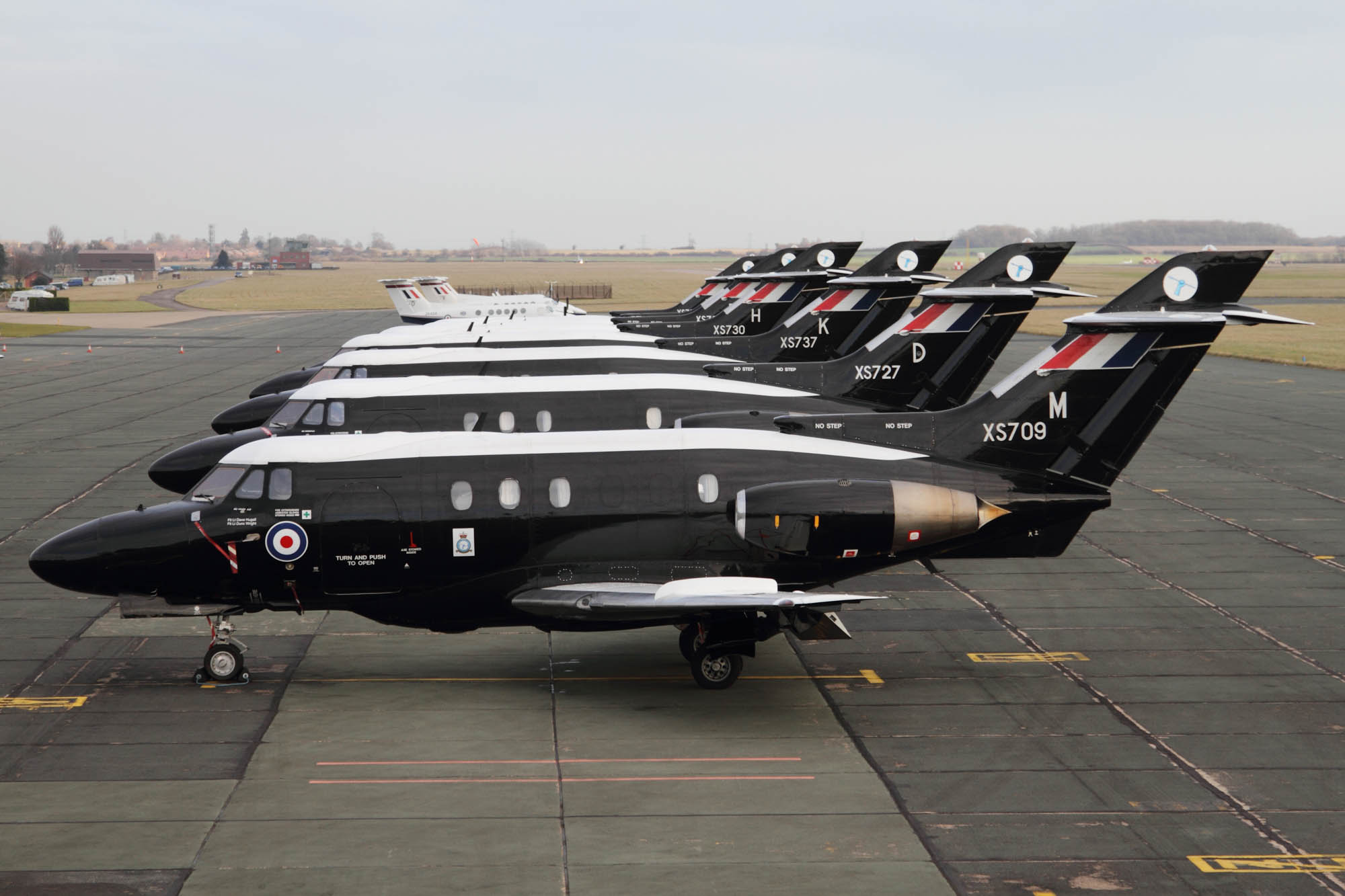 |
| The final line-up after the six-ship formation returned to RAF Cranwell. |
Taxiing out and departing 10 in ten second intervals and the formation flypast one hour later.
Left to right: BAE Systems Dominie T.1 (XS709 'M') heads the final line-up at RAF Cranwell |
| Left to right: Dominie T.1s (XS727 'D' and XS709 'M') the two air spares that were not needed for the six-ship formation. |
After the turn and break they taxied back to the ramp.
Left to right: Dominie T.1 XS737 'K' taking its place in the line and XS739 'F' the last one to taxi back. |
| The final line-up of Dominie's (XS709 'M', XS727 'D', XS737 'K', XS730 'H', XS728 'E', XS712 'A' and XS731 'J'). |
